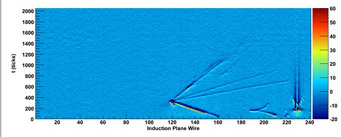DUNE (Deep Underground Neutrino Experiment)
The Deep Underground Neutrino Experiment (DUNE) is a proposed U.S.-based neutrino oscillation , nucleon decay, and SN burst detection experiment. The DUNE experiment will be a next generation long baseline neutrino experiment that will utilize an on-axis wide-band neutrino beam originating at Fermilab, near Chicago, Illinois. The beam will travel about 1300 km through

the earth to a far detector located in Lead, SD. The primary physics goals of the LBNE experiment are to measure the CP violating phase angle, improve the precision of the measured value of θ13, and determine the sign of Δm213 (i.e. determine the neutrino mass hierarchy). In addition to neutrino oscillation physics, the LBNE physics program will also include searches for proton decays, supernova burst neutrinos, and solar neutrino measurements.
In early 2012, the Department of Energy stipulated that DUNE would need to be constructed in a phased approach. The first phase of the experiment will be comprised of a 10 kiloton liquid argon (LAr) time projection chamber located a mile underground in the Homestake mine – in the path of a 1.2 MW neutrino beam from Fermilab. Studies are underway to optimize the design of the 10 kiloton detector. The CSU LBNE group has a significant role on this process. My group is focused on designing and prototyping a design for a photon detection system that will enhance the performance of the LAr TPC. I am currently the project leader for this detector project.
Prior to our work on the LAr photon detection system we developed prototype light collectors designed to increase the light collection efficiency of high quantum efficiency photomultiplier tubes proposed to instrument a 200 kt water Cerenkov detector (one of the two original far detector options).
